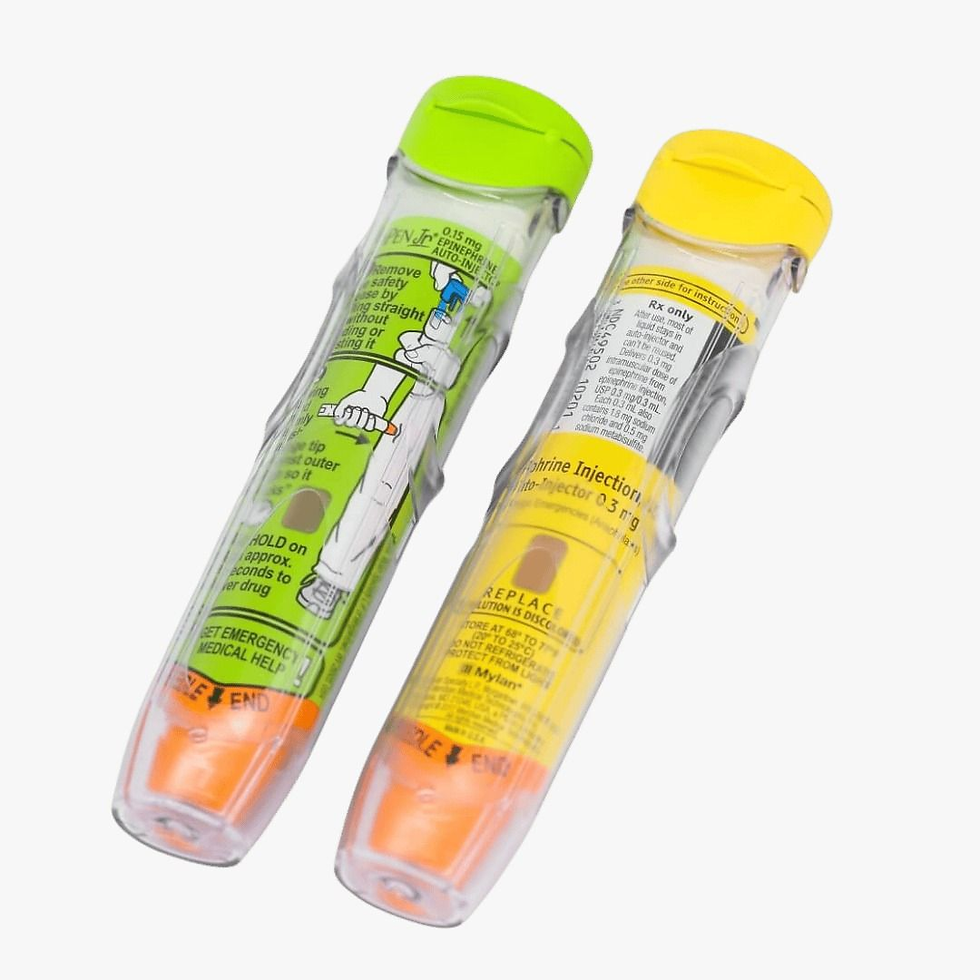Anaphylaxis
- Nina K
- Jun 14
- 4 min read
Anaphylaxis is a sudden and potentially life-threatening allergic reaction that requires immediate treatment. It differs significantly from mild allergic reactions and can affect multiple body systems quickly.
How to recognize anaphylaxis compared to a mild allergic reaction?
Mild allergic reactions usually involve superficial symptoms that do not affect the airways or cardiovascular system. These may include localized rash, itching, runny nose, watery eyes, or mild swelling at the site of exposure. Such reactions can be managed with oral antihistamines like cetirizine (Zyrtec), loratadine (Claritin), desloratadine (Aerius), or fexofenadine (Telfast). In some cases, a short course of oral corticosteroids is added, especially when itching is severe or prolonged. It's important to monitor symptoms closely — if they worsen or spread, medical attention is needed.
Anaphylaxis typically involves more than one body system and progresses rapidly. In addition to skin symptoms such as widespread hives or swelling of the lips or throat, it may include respiratory symptoms (shortness of breath, wheezing, throat tightness), cardiovascular symptoms (dizziness, fainting, low blood pressure), and gastrointestinal symptoms. These GI signs can include nausea, vomiting, severe abdominal pain, diarrhea, bloating, or a sudden unexplained feeling of internal heat. The appearance of such symptoms, especially after exposure to a known allergen, requires immediate administration of adrenaline and urgent medical evaluation.
Causes of anaphylaxis
Common triggers include certain foods (like nuts, shellfish), insect stings (bees, wasps), medications (antibiotics, NSAIDs), and latex.
Emergency treatment of anaphylaxis

The primary treatment is an immediate injection of adrenaline (also known as epinephrine). This medicine works quickly to open airways, improve blood flow, and reduce swelling.
Adrenaline injection doses by age:
Adults and children over 12 years: 0.3–0.5 mg intramuscularly
Children 6–12 years: 0.3 mg intramuscularly
Children 1–5 years: 0.15 mg intramuscularly
Infants under 1 year: 0.01 mg/kg up to 0.15 mg intramuscularly
Repeat the injection every 5–15 minutes if symptoms persist.
Call emergency services immediately after giving adrenaline.
Additional treatments
Oral antihistamines can help relieve itching and hives but do NOT replace adrenaline in anaphylaxis. Common antihistamines available in Israel include cetirizine (זירטק), loratadine (לורסטין), and fexofenadine (טלפסט).
Oral corticosteroids (steroids) may be prescribed to reduce prolonged or biphasic allergic reactions but do not act quickly enough for emergency treatment.
Treatment of mild allergic reactions
For minor symptoms like localized rash or itching without breathing or cardiovascular issues, oral antihistamines and observation may be enough.
If symptoms worsen or spread to involve breathing difficulties, adrenaline injection and emergency care are necessary.
When to seek medical help immediately?
Difficulty breathing, wheezing, or tightness in the throat or chest
Swelling of face, lips, tongue, or throat
Dizziness, fainting, or a drop in blood pressure
Rapid progression of skin symptoms with other systemic signs
If you or someone near you has these signs after exposure to a known allergen or unknown cause, give adrenaline immediately and call for emergency medical help.Anaphylaxis: Recognizing and
Treating Severe Allergic Reactions
Anaphylaxis is a sudden and potentially life-threatening allergic reaction that requires immediate treatment. It differs significantly from mild allergic reactions and can affect multiple body systems quickly.
How to recognize anaphylaxis compared to a mild allergic reaction?
Mild allergic reactions usually involve only one body system, mainly the skin, with symptoms like localized itching, redness, small swelling, or hives (also called nettle rash or urticaria). These reactions are uncomfortable but not life-threatening.
Anaphylaxis affects at least two body systems simultaneously, such as the skin and respiratory system or the skin and cardiovascular system. Symptoms include widespread hives, swelling of the lips or throat, difficulty breathing, wheezing, tightness in the chest, dizziness, fainting, or a drop in blood pressure. These signs require urgent medical care.
Causes of anaphylaxis
Common triggers include certain foods (like nuts, shellfish), insect stings (bees, wasps), medications (antibiotics, NSAIDs), and latex.
Emergency treatment of anaphylaxis
The primary treatment is an immediate injection of adrenaline (also known as epinephrine). This medicine works quickly to open airways, improve blood flow, and reduce swelling.
Adrenaline injection doses by age:
Adults and children over 12 years: 0.3–0.5 mg intramuscularly
Children 6–12 years: 0.3 mg intramuscularly
Children 1–5 years: 0.15 mg intramuscularly
Infants under 1 year: 0.01 mg/kg up to 0.15 mg intramuscularly
Repeat the injection every 5–15 minutes if symptoms persist.
Call emergency services immediately after giving adrenaline.
Additional treatments
Oral antihistamines can help relieve itching and hives but do NOT replace adrenaline in anaphylaxis. Common antihistamines available in Israel include cetirizine (זירטק), loratadine (לורסטין), and fexofenadine (טלפסט).
Oral corticosteroids (steroids) may be prescribed to reduce prolonged or biphasic allergic reactions but do not act quickly enough for emergency treatment.
Treatment of mild allergic reactions
For minor symptoms like localized rash or itching without breathing or cardiovascular issues, oral antihistamines and observation may be enough.
If symptoms worsen or spread to involve breathing difficulties, adrenaline injection and emergency care are necessary.
When to seek medical help immediately?
Difficulty breathing, wheezing, or tightness in the throat or chest
Swelling of face, lips, tongue, or throat
Dizziness, fainting, or a drop in blood pressure
Rapid progression of skin symptoms with other systemic signs
If you or someone near you has these signs after exposure to a known allergen or unknown cause, give adrenaline immediately and call for emergency medical help.


